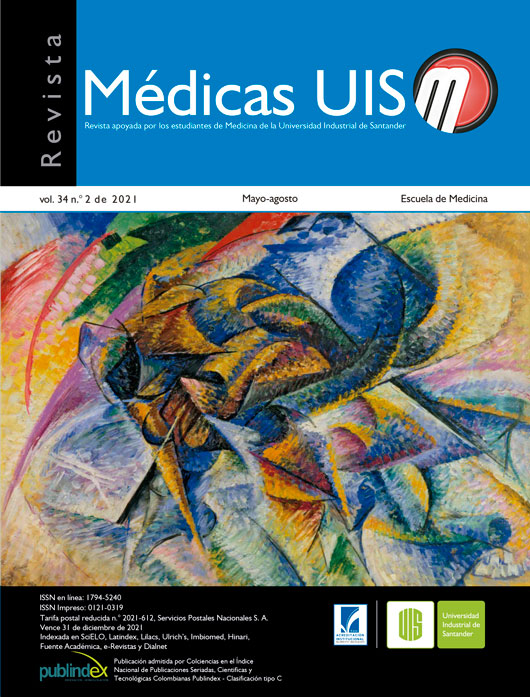Abstract
Purple urine bag syndrome is a rare entity, with a prevalence of up to 8% in patients with chronic indwelling catheters for more than 2 years. This condition occurs in bladder catheter carriers, being the main clinical sign the appearance of purple urine, due to the production of sulphatases and phosphatases by Enterobacteriaceae. We present a clinical case of a 63-year-old woman with a diagnosis of neurogenic bladder and a history of cerebrovascular disease and motor sequelae due to brain neoplasia, who consulted for presenting that urine characteristic color, with symptoms of lower urinary tract infection. She was treated with nitrofurantoin and she had normalization of urinary color on the fifth day of treatment. The diagnosis of this syndrome implies a challenge for the physician, and risk factors must be detected to provide adequate antimicrobial management and avoid the use of unnecessary diagnostic resources.
References
Iglesias Barreira R, Albinana Perez MS, Rodriguez Penin I, Bilbao Salcedo J. Purple urine bag syndrome in two institutionalised patients. Rev Esp Geriatr Gerontol. 2013;48(1):45-7.
Khan F, Chaudhry MA, Qureshi N, Cowley B. Purple urine bag syndrome: an alarming hue? A brief review of the literature. Int J Nephrol. 2011;2011:1-3.
Kalsi DS, Ward J, Lee R, Handa A. Purple Urine Bag Syndrome: A Rare Spot Diagnosis. Dis Markers. 2017;2017:9131872.
Barlow G, Dickson J. Purple urine bags. The Lancet. 1978;311(8057):220-1.
Aubert CJ, Alvarado Lavado FJ, Sanchez Calso A, Gonzalez Gonzalez J. Purple urine in the bag. Semergen. 2016;42(4):25-6.
Agakapis DI, Massa EV, Hantzis I, Paschoni E, Satsoglou E. Purple Urine Bag Syndrome: a case report of an alarming phenomenon. Hippokratia. 2014;18(1): 92-4.
Su YJ, Lai YC, Chang WH. Purple urine bag syndrome in a dead-on-arrival patient: Case report and articles reviews. Am J Emerg Med. 2007;25(861):5–6.
Su FH, Chung SY, Chen MH, Sheng ML, Chen CH, Chen YJ, et al. Case analysis of purple urine-bag syndrome at a long-term care service in a community hospital. Chang Gung Med J. 2005;28(9):636-42.
Mantani N, Ochiai H, Imanishi N, Kogure T, Terasawa K, Tamura J. A case-control study of purple urine bag syndrome in geriatric wards. J Infect Chemother 2003;9(1):53-7.
Corcos J, Ginsberg D, Karsenty G. Textbook of the Neurogenic Bladder. 3rd ed. Boca Raton: CRC Press; 2015.
Dorsher PT, McIntosh PM. Neurogenic bladder. Adv Urol. 2012;2012:816274.
Lansang RS, Krouskop AC. Bladder management. In: Massagli TL, et al., editors. eMedicine. 2004.
Arcay Ferreiro E, Ferro Castaño AM, Fernández González B, García Rodríguez B, González Gómez JM. Sondaje vesical: protocolo de Enfermería. Enfuro. 2004;(90):7-14.
Demelo-Rodríguez P, Galán-Carrillo I, Del Toro-Cervera J. Purple urine bag syndrome. Eur J Intern Med. 2016;35:e3-4.
Campbell SE, Izquierdo A, Campbell S, Erazo L, Calderón C. Síndrome de la bolsa de orina púrpura. Acta Med Colomb. 2011;36(1):38-40.
Chassin-Trubert C AM. Purple urine bag syndrome: report of one case. Rev Med Chil. 2014;142(11):1482-4.
Zanetti M, Ku V, Ruíz J, González E. Síndrome de la bolsa de orina púrpura: Presentación de un caso. Cuad med forense. 2012;18(3-4):153-6.
Yang H-W, Su Y-J. Trends in the epidemiology of purple urine bag syndrome: A systematic review. Biomed Rep. 2018;8(3):249–56.
Hadano Y, Shimizu T, Takada S, Inoue T, Sorano S. An update on purple urine bag syndrome. Int J Gen Med. 2012;5:707-10.
Mumoli N, Vitale J, Brondi B, Basile V, Cei M. Purple urine bag syndrome in a department of medicine. J Am Geriatr Soc. 2013;61:2240-1.
Magallanes Gamboa JO, Notario Barba V. Síndrome de la orina púrpura. Rev Clín Med Fam. 2017;10(3):205-7.
Lee J. Images in clinical medicine. Purple urine. N Engl J Med. 2007;357(13):e14.
Zanetti M, Ku V, Ruíz J, González E. Síndrome de la bolsa de orina púrpura: Presentación de un caso. Cuad med forense. 2012;18(3-4):153-6.
Rooney H, Mokool L, Ramsay A, Nalagatla S. Purple urine bag syndrome: a truly harmless sign? Scott Med J. 2018;63(3):99–101.
Hooton T, Bradley S, Cardenas D, Colgan R, Geerlings S, Rice J, et al. Diagnosis, Prevention, and Treatment of Catheter Associated Urinary Tract Infection in Adults: 2009 International Clinical Practice Guidelines from the Infectious Diseases Society of America. Clin. Infect. Dis. [Internet]. 2010;50(5):625–663. Disponible en: https://doi.org/10.1086/650482.
Kang CI, Kim J, Park DW, Kim BN, Ha US, Lee SJ, et al. Clinical Practice Guidelines for the Antibiotic Treatment of Community Acquired Urinary Tract Infections. J. Infect. Chemother. [Internet]. 2018;50(1):67-100. Disponible en: doi: https://doi.org/10.3947/ic.2018.50.1.67.
Marien T, Miller NL. Treatment of the Infected Stone. Urol. Clin. North Am. 2015; 42(4):459-72.
Brown PD. Management of urinary tract infections associated with nephrolithiasis. Curr. Infect. Dis. Rep. 2010; 12(6):450-4.
Romero Cullerés G, Sugrañes JC, Planells Romeo I, Giménez Pérez M. Characteristics of urinary tract infections in different patient subpopulations and depending on the bladder emptying system. Actas Urol Esp. 2010; 34(3):251-7.

This work is licensed under a Creative Commons Attribution 4.0 International License.
Copyright (c) 2021 Médicas UIS
